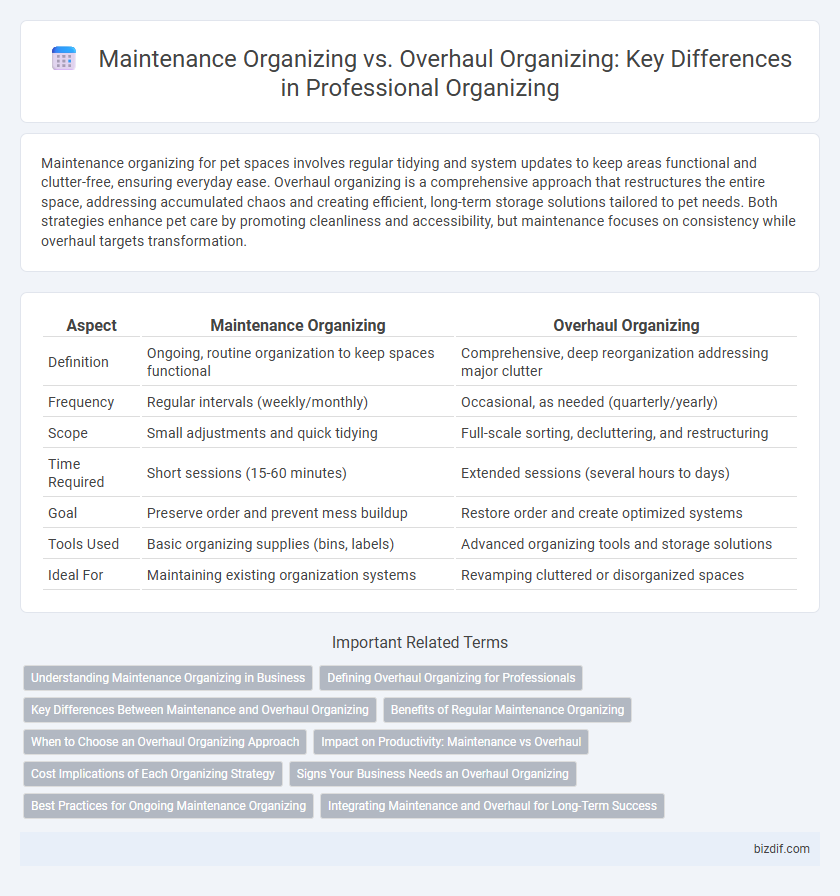Maintenance organizing for pet spaces involves regular tidying and system updates to keep areas functional and clutter-free, ensuring everyday ease. Overhaul organizing is a comprehensive approach that restructures the entire space, addressing accumulated chaos and creating efficient, long-term storage solutions tailored to pet needs. Both strategies enhance pet care by promoting cleanliness and accessibility, but maintenance focuses on consistency while overhaul targets transformation.
Table of Comparison
| Aspect | Maintenance Organizing | Overhaul Organizing |
|---|---|---|
| Definition | Ongoing, routine organization to keep spaces functional | Comprehensive, deep reorganization addressing major clutter |
| Frequency | Regular intervals (weekly/monthly) | Occasional, as needed (quarterly/yearly) |
| Scope | Small adjustments and quick tidying | Full-scale sorting, decluttering, and restructuring |
| Time Required | Short sessions (15-60 minutes) | Extended sessions (several hours to days) |
| Goal | Preserve order and prevent mess buildup | Restore order and create optimized systems |
| Tools Used | Basic organizing supplies (bins, labels) | Advanced organizing tools and storage solutions |
| Ideal For | Maintaining existing organization systems | Revamping cluttered or disorganized spaces |
Understanding Maintenance Organizing in Business
Maintenance organizing in business focuses on sustaining the efficiency and order of existing systems through regular updates and minor adjustments, ensuring consistent productivity without major disruptions. It involves routine tasks such as inventory management, workflow assessments, and decluttering to prevent accumulation of inefficiencies. Unlike overhaul organizing, maintenance emphasizes continuous, incremental improvements that support long-term business stability.
Defining Overhaul Organizing for Professionals
Overhaul organizing involves a comprehensive, systematic restructuring of spaces and systems to optimize functionality and efficiency, addressing accumulated clutter and inefficiencies that routine maintenance cannot resolve. Professional organizers perform detailed assessments, implement strategic categorization, and redesign storage solutions to create sustainable organizational frameworks. This process prioritizes long-term usability and adaptability, differentiating it from regular maintenance organizing, which focuses on preserving order within established systems.
Key Differences Between Maintenance and Overhaul Organizing
Maintenance organizing involves regularly scheduled tasks aimed at sustaining order and preventing clutter buildup, focusing on consistency and minor adjustments. Overhaul organizing requires a comprehensive decluttering process, addressing deep-seated disorganization by reevaluating and restructuring spaces or systems extensively. The key difference lies in maintenance prioritizing ongoing preservation, while overhaul centers on transformative change to restore functionality.
Benefits of Regular Maintenance Organizing
Regular maintenance organizing enhances productivity by keeping spaces consistently tidy and functional, reducing time wasted on searching for items. It prevents clutter buildup, promoting a stress-free environment and improving overall efficiency. Consistent upkeep also prolongs the lifespan of organizational systems, minimizing the need for extensive overhauls.
When to Choose an Overhaul Organizing Approach
Choose an overhaul organizing approach when clutter accumulates beyond manageable levels, causing inefficiency and stress in daily routines. This method suits spaces neglected for extended periods, requiring comprehensive decluttering, deep cleaning, and systemic reorganization to restore function and order. Overhaul organizing addresses root causes of disarray, creating sustainable systems tailored for long-term maintenance.
Impact on Productivity: Maintenance vs Overhaul
Maintenance organizing ensures consistent workspace efficiency by addressing small clutter issues regularly, preventing disruptions in workflow and sustaining steady productivity levels. Overhaul organizing involves comprehensive restructuring that temporarily slows operations but results in significant long-term productivity gains through improved systems and space utilization. Prioritizing maintenance organizing reduces the frequency of major overhauls, optimizing daily work performance and minimizing downtime.
Cost Implications of Each Organizing Strategy
Maintenance organizing requires consistent, small investments to sustain order and prevent clutter buildup, resulting in lower ongoing costs and reduced need for major interventions. Overhaul organizing demands significant upfront expenses for deep decluttering, restructuring, and comprehensive reorganization, which can lead to higher initial costs but fewer frequent maintenance expenses. Choosing the appropriate strategy depends on budget allocation, long-term cost efficiency, and the current state of the space.
Signs Your Business Needs an Overhaul Organizing
Signs your business needs an overhaul organizing include persistent clutter disrupting workflow, frequent missed deadlines due to disorganization, and stagnant productivity despite maintenance efforts. When filing systems become obsolete and digital tools no longer streamline tasks efficiently, a comprehensive restructure is necessary. Overhaul organizing addresses deep-rooted inefficiencies by redesigning processes, optimizing space, and implementing robust organizational systems tailored to evolving business needs.
Best Practices for Ongoing Maintenance Organizing
Best practices for ongoing maintenance organizing emphasize consistent decluttering, regular review of storage solutions, and habit formation to sustain order. Utilizing labeled containers, digital inventory systems, and scheduled clean-up sessions prevents accumulation and promotes efficiency. Establishing clear routines and involving all household members ensures long-term adherence to organized spaces without the need for major overhauls.
Integrating Maintenance and Overhaul for Long-Term Success
Integrating maintenance organizing with overhaul organizing enhances long-term efficiency by ensuring continuous order and periodic deep restructuring within professional organizing systems. Maintenance organizing emphasizes routine upkeep and small adjustments to sustain functionality, while overhaul organizing focuses on comprehensive, large-scale reorganization to address accumulated clutter or system inefficiencies. Combining these approaches creates a balanced strategy that promotes consistent productivity and adaptability over time.
maintenance organizing vs overhaul organizing Infographic

 bizdif.com
bizdif.com